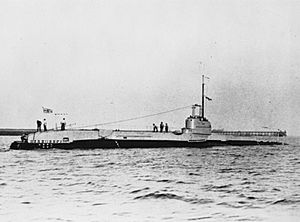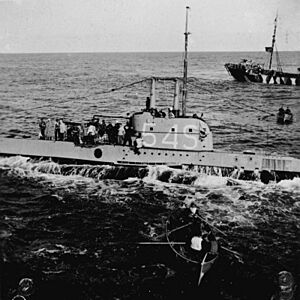HMS Shark (54S) facts for kids

Shark on the surface
|
|
Quick facts for kids History |
|
|---|---|
| Name | HMS Shark |
| Ordered | 2 January 1933 |
| Builder | Chatham Dockyard |
| Laid down | 12 June 1933 |
| Launched | 31 May 1934 |
| Commissioned | 31 December 1934 |
| Fate | Scuttled, 6 July 1940 |
| Badge | |
| General characteristics | |
| Class and type | S-class submarine |
| Displacement |
|
| Length | 208 ft 8 in (63.6 m) |
| Beam | 24 ft 0 in (7.3 m) |
| Draught | 11 ft 10 in (3.6 m) |
| Installed power |
|
| Propulsion |
|
| Speed |
|
| Range |
|
| Test depth | 300 feet (91 m) |
| Complement | 40 |
| Armament |
|
HMS Shark was a special type of submarine built for the Royal Navy in the 1930s. It was part of the S-class submarines, which were designed to operate in the North Sea and Baltic Sea. Shark played a role in the Second World War and is even mentioned in a song called "Twelve Little S-Boats".
Contents
What was HMS Shark like?
The S-class submarines, like Shark, were built to be a bit bigger and better than earlier submarines of their kind. They were about 208 feet 8 inches (63.6 m) long, which is longer than two tennis courts! They were also about 24 feet 0 inches (7.3 m) wide.
How deep could it go?
These submarines could dive down to 300 feet (91 m) underwater. That's like diving to the bottom of a 30-story building! When it was on the surface, Shark weighed about 768 long tons (780 t). Underwater, it weighed even more, around 960 long tons (980 t).
How fast could it travel?
Shark had two powerful diesel engines for moving on the surface. These engines helped it reach speeds of about 13.75 knots (25.47 km/h; 15.82 mph) (knots). When it was underwater, it used two electric motors, which allowed it to travel at about 10 knots (19 km/h; 12 mph). It could travel a very long way on the surface, about 6,000 nautical miles (11,000 km; 6,900 mi) (nautical miles) at a speed of 10 knots (19 km/h; 12 mph).
What weapons did it have?
The S-class submarines were well-armed. They had six torpedo tubes at the front, which could fire powerful 21-inch (533 mm) torpedoes. They carried 12 torpedoes in total. They also had a deck gun that was 3 inches (76 mm) (76 mm) in size, which could be used when the submarine was on the surface.
Who was on board?
A crew of 40 people, including officers and sailors, worked and lived on HMS Shark.
HMS Shark's Journey and Fate
Shark was ordered on 12 June 1933 and started being built very soon after. It was built at HM Dockyard, Chatham in England. The submarine was launched into the water on 31 May 1934 and was ready for service by 31 December 1934.
The Attack and Sinking
In July 1940, during World War II, Shark was on patrol off the coast of Norway. On 5 July, while it was coming to the surface, German aircraft attacked it. The crew of Shark fought back bravely and even managed to shoot down one of the German planes, a Dornier Do 17.
However, the submarine was badly damaged and couldn't dive or steer properly. To prevent the Germans from capturing their submarine, the crew made the difficult decision to sink Shark themselves.
The next day, German ships arrived and took the crew on board. As the Germans tried to tow Shark away, the British crew had already opened valves to flood the submarine. To the cheers of the captured British sailors, the German crews had to quickly cut the ropes because Shark was sinking fast and would have pulled their ships down too! Shark sank stern first about 25 nautical miles (46 km) west-south-west of Egersund, Norway.
Brave Crew Members
The crew of Shark showed great courage, even after being captured.
Lieutenant Commander Peter Buckley
The captain of Shark, Lieutenant Commander Peter Buckley, was held in a prisoner of war camp. He was involved in planning many attempts to escape from the camp.
ERA W. E. "Wally" Hammond
Another crew member, ERA W. E. "Wally" Hammond, also tried to escape many times. He was eventually held in a famous prison camp called Oflag IV-C – Colditz. Wally, along with another sailor named Don "Tubby" Lister (from another captured submarine, HMS Seal), managed a very clever escape. They argued that they weren't officers, so they shouldn't be in an officer's prison camp. They were transferred to a different prison. From there, Wally escaped from a work party and made it all the way to England through Switzerland in 1943!
Images for kids




